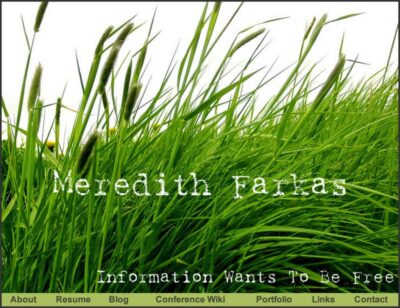We talk a great deal about the importance of being more transparent to our patrons. Things like blogs, flickr, etc. can help put a human face on the library, make us seem more approachable and friendly. For my August column for American Libraries (which I just finished) I wrote about how Virginia Commonwealth University’s library publishes all of the feedback and questions they get via their online suggestion form to their Library Suggestions Blog. The suggestions are then responded to by relevant staff members who either explain a policy or describe what is being done to fix the problem. It’s a terrific blog and a great example of libraries that are really trying to be transparent and responsive to patron feedback.
Being transparent definitely isn’t enough though. It’s no substitute for actually doing something about the things patrons identify as problems. I’m going to illustrate this with two examples from the corporate world. In both examples, these organizations dealt with complaints with transparency, but only one of them did it successfully. If you’re going to be open in that way, you will also have to do something about the things that people bring up as problems.
My husband is a big car fan, which is not something I’ve ever understood, but I’m usually understanding enough not to delete his car shows from the TiVo. For as long as I’ve known him (and for more than a decade before that — maybe two), he’s been a loyal subscriber to Car and Driver magazine. That is, until recently when he let his subscription lapse. What would make such a loyal subscriber leave the magazine? Well, it’s the same thing that has recently led many loyal subscribers of Car and Driver to throw their hands up in disgust: the magazine’s redesign.
It’s quite obvious though that they took significant amounts of money out of the print publication and dumped it into the Website. They’ve abandoned their traditional market to go after a new one. The new and improved Website now contains mobile content, podcasts, a fancy buyers guide (for people looking to buy cars, not enthusiasts), and much more. If you look at the press release you can see that they have decided to design the Website with the consumer in mind and have even taken things out of the magazine and put them on the Website instead (like the comparison charts) so that the consumers can benefit.
So the Website is for consumers and the magazine is for enthusiasts. Great! Well… no. Unfortunately, they have basically cut the magazine off at the knees. They made it physically smaller with more ads and less actual content. They made the print significantly smaller and harder to read. They got rid of a long-time columnist that everyone loved (or at least loved to disagree with). One of the heads of the publishing group that publishes C & D said “”With these new channels of distribution, we are able to broaden the audience and deliver branded content that is credible, authoritative and influential wherever, whenever and however, the consumer wants it.” However, it’s patently obvious that they have not broadened the audience so much as shifted away from the old audience and towards a new one. And the traditional audience, some of whom have been subscribing since the 1950s, are fuming.
(Aside: As I’m writing this, I realize this offers another lesson that librarians need to heed. While it’s important that we provide better services for teens and those in their early 20s, we shouldn’t do it at the expense of services to the rest of our patrons. We do not want to lose that core audience any more than we want to lose the Gen Y folks.)
The magazine had a lot of feedback sent to them since the redesign went into effect with the December 2006 issue. You could argue that the people who don’t like these changes are old luddites who are afraid of change, but look at the comments in the forums on Car and Driver’s Website (the comments go on for pages and pages)! These people are using the Website at least, so you can’t say they’re not Web savvy. And the issues seem to go to the heart of the design (colors, font, organization, content, etc.). It’s not that these people don’t like change; they don’t like bad change.
So how did the folks at Car and Driver respond to this? Well, the editor discussed how much negative feedback they’d gotten by mail and basically blew it off:
“Mail about the redesign ran 164 against and 13 for. Readers howled about changing type fonts and all-cap headlines and hard-to-read type and how we complicated a once-simple spec page, not to mention making the Web site part of the experience… But we paid big bucks for this redesign, and we ain’t going back”
Yikes! After that, the hate mail really flew in and the editor wrote again about the redesign in the June issue. When Adam showed me the article, I was floored by how bizarre it was. So almost an entire page was devoted to quotes from angry readers. Here was my favorite. “I was distressed to learn that some home-slice in your phone-it-in art department outbid me on eBay for the 1970’s-era Popular Mechanics road-test lithography plates that you are now using to ‘convey information’ to your readers regarding automobile performance. I am equally distressed at how my eyeballs hurt when I try to look at those obnoxious clashing colors, apparently chosen for their ability to induce eye-strain and send the reader running for his computer screen to finish reading the reviews.” (I must admit, that I got eyestrain just trying to look at the magazine print while typing in that quote.)
Wow! Way to be transparent, huh? Ok, so you would expect that after that, you’d see something that says, “in the next issue we will be changing ___, ___, and ___.” But this is how the column ended:
Informed that the vote is 303 to 21 against us, Ed. [the editor] replied, “Most people write to a magazine when they’re angry, not when they’re happy.” The arrogance continues.
But keep your eyes on these pages. Maybe we have run over our own foot. A redesign always has elements of a work in progress, and we’ll likely be making tweaks in the months ahead. In the meantime, we’ve got Ed. signed up for a Dale Carnegie course.
Just saying that things may change isn’t enough. The thing about being transparent and opening yourself up to feedback is that you have to be willing to change when you get that feedback. If not, it will only serve to make you look worse than if you’d never asked for feedback in the first place. You may be married to your new Web design and you may think the new hours that reference librarians are available is better for everyone, but if you get negative feedback from your patrons (and I don’t just mean one or two people who you know don’t like anything new), you need to be willing to make changes. You can’t just blow their feedback off. And I’ve seen feedback blown off in the library world. That “we know better than the patron” attitude. I’m sure the folks at Car and Driver figure that those who don’t like the redesign just hate anything new and hate the Web. Does that describe my husband who owns a software company and reads just about everything off the Web other than his (now former) favorite magazine Car and Driver?
My example of great customer service and transparency also comes from the corporate realm. Southwest Airlines has a blog that I absolutely love. Nuts About Southwest features posts from the CEO, airline pilots, flight attendants, customer service reps, maintenance folks, and more. Their stories are about what goes on in the airports, the cockpit and in the corporate offices. The site really gives readers a great window into the goings on of an airline and puts a human face on what is a large corporate entity. It’s the perfect example of a corporate blog and more companies should follow this model.
Well, back in January, the head of Schedule Planning for the airline, Bill Owen, wrote a post entitled Why Can’t I Make Reservatons Further in Advance?, attempting to explain how and why Southwest does scheduling they way they do. He was attempting to show how the passengers were actually better-served by not being able to book earlier since most airlines will change their schedules. However, their readers were not happy with this answer. There were 253 comments on the post, most of which are telling Southwest that they were not happy with this policy.
So, what did Southwest do about this? Did they say “well, this is the way we do it so there!”? Nope. In I Blogged, You Flamed, We Changed, Owen wrote about what had happened since he wrote his last post two and a half months before:
Talk about sticking your head into a hornet’s nest! We got 274 replies, and from the tone of some of them we quickly realized that, at least for some of you, a few of our policies were out of step with your travel needs. So…..we’re changing! We heard, from both Customers and Employees alike, that you didn’t like our policy of not publishing the dates on which we plan to extend the schedule. No problem! We now make the tentative, planned date of the next schedule extension available to our Reservations Agents, and in short order this information will be prominently displayed at southwest.com… As they say in the commercials….”but wait! There’s more!” Effective immediately, we will consider 120 days of bookable inventory as our minimum when getting our schedule ready for peak travel periods, such as summer or the Holiday Season.
I’m sure it was very hard to make this change. The scheduling folks have to change the way they do their job, which is definitely not something people usually enjoy doing. But they saw that people didn’t like what they were doing, and they changed it. And the response was very positive: “I certainly admire the way you handled the whole situation last time. It speaks volumes about you, your team, and SWA in general that you are making small changes based on what your clients – the passengers – are asking for.”
Being more transparent and human is at the heart of what Library 2.0 is all about. Being open to feedback is the best way to know what your users want. Before you think about being more transparent, before you open yourself up to feedback, make sure you are willing to make changes. Because being transparent alone is not enough; you have to be willing to put your money where your mouth is. We just can’t be married to the way we do things.
Update: I’m not saying that we can or even should make every change our patrons want. Sometimes those changes aren’t economically feasible. Sometimes they would be bad for other patrons. But you can be transparent and explain the reasoning to your patrons, making them feel like you take them seriously and are trying to meet their needs to the best of your abilities.




Great points and thank you for bringing attention to a great idea. Libraries need to be more transparent in this way since it shows they are aware of the problem and are doing something about it.
However, there is the problem of the in-between extremes. Yes, if you get flamed like that, you should be doing an about-face, but what about a smaller suggestion. If it’s something the library cannot accomplish, are they bad? I know I received suggestions about making our magazines available for check-out. I would like to, but currently the resources aren’t there, and I explained that we are reviewing it. Is that not transparent enough?
I think as long as you are showing the user that you take their suggestions seriously and either show that you’re doing something about it or give them a good reason why you can’t change it (like it would be bad for other patrons, don’t have funding yet, etc.) you’re in good shape. We can’t always do what our patrons want, but you can still make them feel like we take their concerns seriously.
I think your answer was fine for that situation, but I think it would also be good to follow up at some time with that patron and let them know what the status is. To just say you’re reviewing it and never follow-up is bad form. If you’re not really reviewing it, then it probably wasn’t a good answer. As long as we’re honest and show that we’re taking their comment seriously, I think we’re doing good.
We’ll never make everyone happy, but you shouldn’t just blow off people’s concerns or make them feel like you don’t care about their concerns. You can let someone know why having magazines for check-out isn’t currently economically feasible while still making them feel like you care about their needs.
Excellent post, one that I’ll save for further analysis. I particularly appreciated your aside, one that doesn’t seem to come up much: Is it reasonable to toss aside or alienate a loyal existing audience in attempts to gain a new audience? I was just about to write a post raising that question based on an entirely different personal incident; maybe I will tomorrow. Obviously the answer is neither “We can’t change because we might alienate somebody” or “We must attract X, so too bad for Y.” The answer, if there is one, is more difficult and more local…and indeed involves both transparency and paying attention, not only to what people say but to what they do. Anyway, great stuff.
Excellent post and comments. I need to think much more about transparency and school libraries. You have much hidden in this little blog post. THank you.
I’m the aforementioned husband and ex-subscriber from the post. The thing that is a touch infuriating about the whole episode was the lack of transparency not afterwards, but before the redesign took place. As far as I can tell, they never once queried us, their existing subscriber base, or even held an informal focus group online to ask us about changes that we might like to see.
Ironically, the redesign hasn’t even endeared them to the new demographic that they were attempting to reach. Car and Driver has become the “Poochie” of auto mags — the harder it tries to look “cool”, the lamer it becomes.
Very good discussion, Meredith, and points to consider. In my system, the great reluctance to respond to suggestions is sometimes used as an argument against being transparent. So, in a bizarre way, I’d rather be ineffectively transparent than not transparent at all.
That said, I’m certainly not advocating ineffective transparency! What I think works well is gradual change. I’m always confounded that any organization declares on such and such a date they’ll be big changes and then confuse the heck out of (or anger) everyone. I like phasing things in little by little, seeing how things go, getting the feedback, tweaking things, and then phasing in whatever’s next. There’s less disruption and you can adjust things on the fly as you see what works and what doesn’t, what people like and what people don’t.
You can’t do this with everything, of course, but it’s amazing how much you CAN do this way. I’m involved in a big intranet changeover this summer, for instance. We worked out the plans months ago and now it’s being built. But between design and rollout, we’ve slowly been morphing our existing site to look like and kind of act like our future one. Links have been slowly renamed and moved around the screen. We’ve been getting comments and adjusting our final product behind the scenes. We hope when the day comes to flip the switch, everyone will be so used to the basics that they’ll shrug and go back to working with it.
In a way it’s so transparent, people barely see it happening!
I think that often libraries (librarians) are not comfortable explaining why a change can’t happen, and that impedes our moving towards transparency. If we don’t have the money, why can’t we say that we don’t have the money? Doesn’t this strengthen our arguments for increased funding in the future? I for one would love to be able to go to a Director/Dean/Provost with documentation from interactions with patrons supporting my needs to increase funding to pay for new, needed, services. Isn’t this part of the new assessment movement as well – collecting qualitative data to support data driven decision making? Transparency can also provide many opportunities for patrons to learn to better advocate for their needs, and assist us in pursuing our goal of supporting their teaching and learning.
And, thank you thank you thank you for bringing up the “patrons only write in when they’re mad about something so we don’t have to take them seriously, and this is clearly a scewed sample” issue. It’s nice to have concrete examples of why that’s not the best way to approach user feedback.
Keep ’em coming!
Great post – great examples of the yin and yang of customer service. Made for a timely discussion topic in a class today. Thanks for the thoughtful blog posting.
Thanks for sharing, I have to say that you have a great blog! That’s really a shame about Car & Driver. I am only 23 and I definitely love the Internet and all, but I also equally love magazines! It’s too bad that people would just completely change their magazine to accomodate their website. I actually used to work at a library myself not too long ago. It was my first job (I was 16 and was a shelver) and I have the utmost respect for anyone who works at a library. Thanks for letting all of us get to know you through the blog!